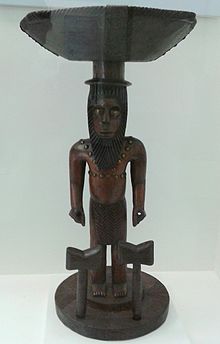
Back Шанго Bulgarian Changó Breton Xangó Catalan Shango German Σάγκο Greek Ŝangoo Esperanto Changó Spanish Ṣàngó Estonian Shangô French Shango Italian
| Shango | |
|---|---|
Thunder, Lightning, Fire, Justice, Dance, Virility | |
| Member of the Orisha | |
 Representation of Ṣàngó, National Museum of Brazil, Rio de Janeiro | |
| Other names | Sango, Ṣàngó, Changó, Xangô, Jakuta, Hevioso, Siete Rayos |
| Venerated in | Yoruba religion, Dahomey mythology, Ewe religion, Vodun, Santería, Umbanda, Candomblé, Haitian Vodou, Louisiana Voodoo, Folk Catholicism |
| Day | The fifth day of the week |
| Color | Red and White |
| Region | Nigeria, Benin, Togo, Ghana,Latin America |
| Ethnic group | Yoruba people, Fon people, Ewe people |
| Genealogy | |
| Spouse | Oya, Oba, Osun |
| Part of a series on |
| Yorùbá people |
|---|
 |
Shango (Yoruba language: Ṣàngó, also known as Changó or Xangô in Latin America; as Jakuta or Badé; and as Ṣangó in Trinidad Orisha[1]) is an Orisha (or spirit) in Yoruba religion. Genealogically speaking, Shango is a royal ancestor of the Yoruba as he was the third Alaafin of the Oyo Kingdom prior to his posthumous deification. Shango has numerous manifestations, including Airá, Agodo, Afonja, Lubé, and Obomin.[2][3] He is known for his powerful double axe (Oṣè). He is considered to be one of the most powerful rulers that Yorubaland has ever produced.
In the New World, he is syncretized with either Saint Barbara or Saint Jerome.
- ^ Salamone, Frank A. (2004). Levinson, David (ed.). Encyclopedia of Religious Rites, Rituals, and Festivals. New York: Routledge. p. 24. ISBN 0-415-94180-6.
- ^ Cite error: The named reference
awas invoked but never defined (see the help page). - ^ Cite error: The named reference
Williamwas invoked but never defined (see the help page).